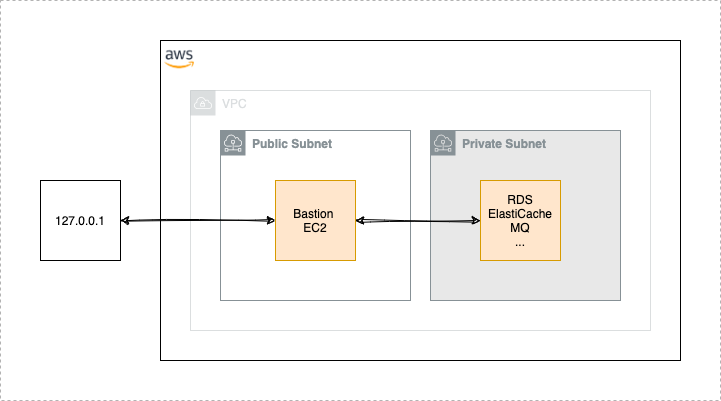The AWS Proxy enables you to reach AWS services which are protected due to a private network.
In a modern infrastructure architecture, services like RDS, ElastiCache, ElasticSearch, MQ etc. should be live in a protected private network which is not accessable from the public. Some of these services are providing web interfaces which are quite helpful to debug problems. But how is it possible to reach them in the browser? And how is it possible to have a look in a database or any other AWS service which is protected and not accessable via the AWS Console?
One way to solve this kind of problem is to open a proxy to these services. And on this way the AWS Proxy as a small CLI utility comes into play to support you with that.
- Go to the Releases Page
- Downloading the binary for your operating system: e.g., if you are on a Mac, download
aws_proxy_darwin_amd64, if you are on Windows, downloadaws_proxy_windows_amd64.exeetc - Rename the downloaded file to
aws_proxy - Add execute permissions to the binary. On Linux and Mac:
chmod u+x aws_proxy - Put the binary somewhere on your PATH. On Linux and Mac:
mv aws_proxy /usr/local/bin/aws_proxy
To open a proxy to your private network services, we need something like an bridge between your public and your private network. This kind of bridge is called a jump host or a bastion server. This is a server which lives in your public network and has access to your private network. For security reasons you should only allow SSH as ingress. Also, you need to have access from you local machine to the bastion server. The AWS Proxy utility assumes that you have access to the bastion with a valid user and a valid SSH key (with or without a passphrase).
AWS Proxy is build like a wizard. You dont need to know specific endpoint or ports, it will fetch all that data from AWS via the AWS SDK. Everything you need is a valid set of CLI credentials. The best way is to have them stored as a profile in ~/.aws.
- RDS
- Elasticsearch (API and Kibana)
- Elasticache (Redis)
- MQ Service (RabbitMQ)
The whole configuration for AWS Proxy is stored in ~/.aws_proxy.yaml.
To create that file with a default set of configuration, just execute:
aws_proxy config
You need to specify the region and your AWS profile
aws:
region: eu-central-1
profile: myprofile
If your bastion server has a static IP and you know that, you could add this information to the configuration file
~/.aws_proxy.yaml
bastion:
public_ip: XX.XX.XX.XX
If you dont know that IP or your bastion server does not have a static IP, AWS Proxy can find that with a tag query.
The default tag query is that your Bastion has a tag with the key Name and the value bastion. You could change that filter in the configuration file. You could also add multiple filter if your AWS account provides multiple different bastion instances.
bastion:
tag_filter:
- name: tag:Name
value: bastion
The default SSH user is ec2-user, the default port is 22 and the default identity file is $HOME/.ssh/id_rsa.
You could change all these default in the configuration file ~/.aws_proxy.yaml.
bastion:
ssh:
user: ec2-user
identity_file: ~/.ssh/rd_rsa
port: 22
If you want to change the local proxy ports, just update the following part
proxy:
local_ports:
rds: 6546
If you need help or if you need some more background information, just use one of the flags:
aws_proxy --help
aws_proxy --verbose
The following command will give you a complete list of all your existing RDS databases. You can choose the one you need.
aws_proxy proxy:rds
You can skip this step if you know the database you want to proxy. Just add the DBName as flag
aws_proxy proxy:rds -n mydbname




